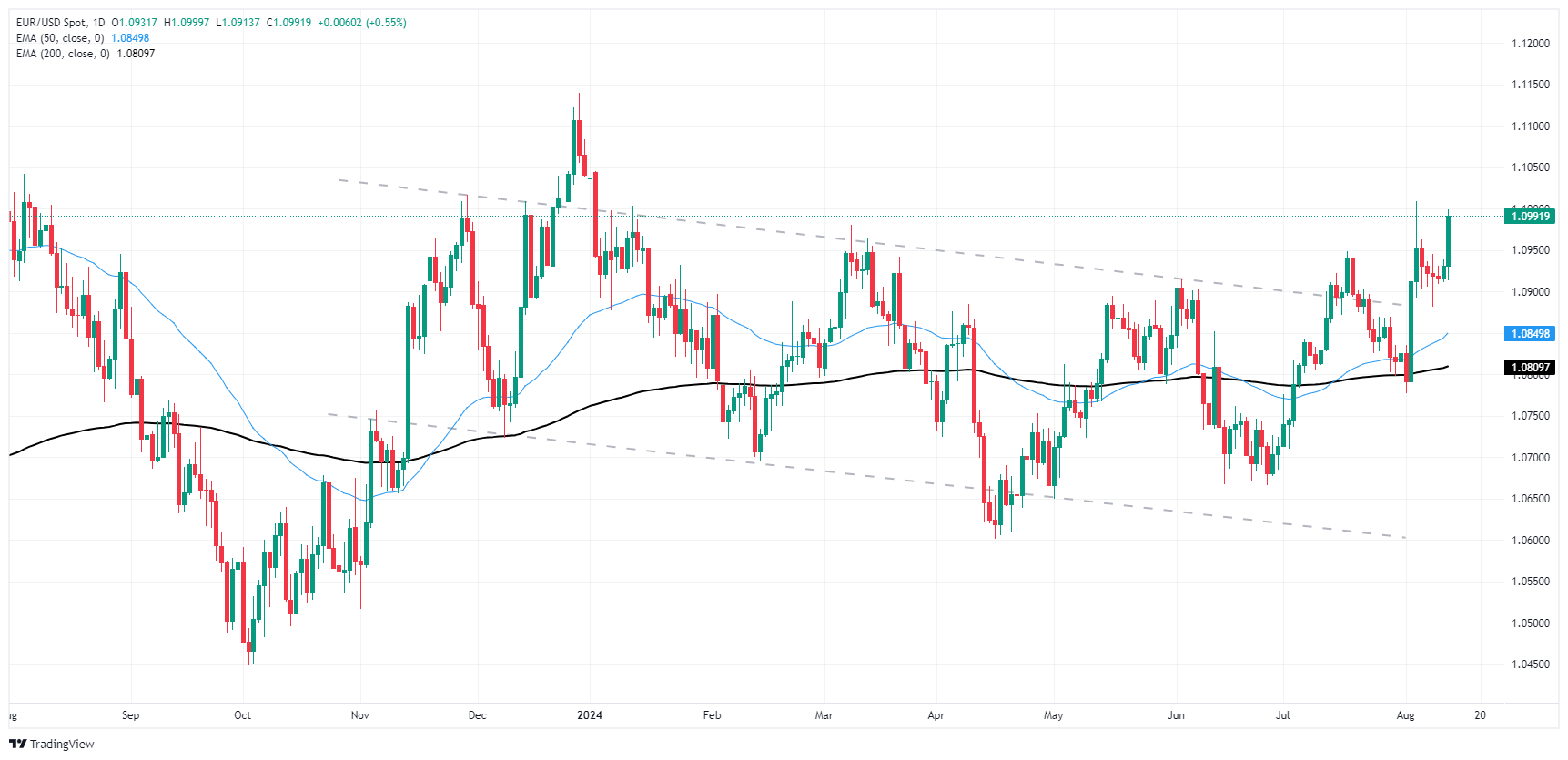- EUR/USD gained over half of a percent on Tuesday.
- Easing US inflation figures bolstered risk appetite, pummeling the US Dollar.
- Key EU GDP growth data remains ahead, as well as US CPI inflation.
EUR/USD climbed on Tuesday, bolstered by a broad weakening of US Dollar bids after US Producer Price Index (PPI) inflation cooled faster than expected. Fiber traders still await pan-EU Gross Domestic Product (GDP) growth numbers slated for early Wednesday, but investors will be broadly focused on upcoming US Consumer Price Index (CPI) inflation figures as risk appetite extends into recovery mode.
Forex Today: Rate cut expectations look at US inflation data
Euro-area GDP for the second quarter is expected to hold steady at previous figures of 0.3% QoQ and 0.6% YoY. While no change is expected, too steep of a deviation in either direction could kick off a fresh round of risk-off selling in Euro markets if the print comes in lower, or add fuel to the current bullish stance if growth finds a bounce.
US CPI inflation is widely expected to continue cooling in July, with markets forecasting core US CPI for the year ended in July to ease to 3.2% from the previous 3.3%. Headline CPI is more of the same, with median market forecasts expecting headline CPI inflation figures to tick down to 2.9% YoY from the previous 3.0%.
US PPI inflation eased to 2.2% YoY in July, falling below the expected 2.3% and declining even further from the previous period’s revised 2.7%. Core PPI inflation also declined to 2.4% for the year ended in July, dropping below the forecast 2.7% and falling well below the previous 3.0%. Continued declines in US inflation pressure bolstered risk appetite in the US market session, and market bets of a 50 basis point double-cut in September from the Federal Reserve (Fed) rose to 55%, according to the CME’s FedWatch Tool.
EUR/USD price forecast
Despite Tuesday’s rally, EUR/USD remains trapped under last week’s peak bids just north of 1.10000. Bullish momentum is set to continue dragging intraday price action higher, but technical weakness remains a real risk as Fiber struggles to develop long-term wheels above the 200-day Exponential Moving Average (EMA) near 1.0820.
EUR/USD daily chart
Euro FAQs
The Euro is the currency for the 20 European Union countries that belong to the Eurozone. It is the second most heavily traded currency in the world behind the US Dollar. In 2022, it accounted for 31% of all foreign exchange transactions, with an average daily turnover of over $2.2 trillion a day. EUR/USD is the most heavily traded currency pair in the world, accounting for an estimated 30% off all transactions, followed by EUR/JPY (4%), EUR/GBP (3%) and EUR/AUD (2%).
The European Central Bank (ECB) in Frankfurt, Germany, is the reserve bank for the Eurozone. The ECB sets interest rates and manages monetary policy. The ECB’s primary mandate is to maintain price stability, which means either controlling inflation or stimulating growth. Its primary tool is the raising or lowering of interest rates. Relatively high interest rates – or the expectation of higher rates – will usually benefit the Euro and vice versa. The ECB Governing Council makes monetary policy decisions at meetings held eight times a year. Decisions are made by heads of the Eurozone national banks and six permanent members, including the President of the ECB, Christine Lagarde.
Eurozone inflation data, measured by the Harmonized Index of Consumer Prices (HICP), is an important econometric for the Euro. If inflation rises more than expected, especially if above the ECB’s 2% target, it obliges the ECB to raise interest rates to bring it back under control. Relatively high interest rates compared to its counterparts will usually benefit the Euro, as it makes the region more attractive as a place for global investors to park their money.
Data releases gauge the health of the economy and can impact on the Euro. Indicators such as GDP, Manufacturing and Services PMIs, employment, and consumer sentiment surveys can all influence the direction of the single currency. A strong economy is good for the Euro. Not only does it attract more foreign investment but it may encourage the ECB to put up interest rates, which will directly strengthen the Euro. Otherwise, if economic data is weak, the Euro is likely to fall. Economic data for the four largest economies in the euro area (Germany, France, Italy and Spain) are especially significant, as they account for 75% of the Eurozone’s economy.
Another significant data release for the Euro is the Trade Balance. This indicator measures the difference between what a country earns from its exports and what it spends on imports over a given period. If a country produces highly sought after exports then its currency will gain in value purely from the extra demand created from foreign buyers seeking to purchase these goods. Therefore, a positive net Trade Balance strengthens a currency and vice versa for a negative balance.
Information on these pages contains forward-looking statements that involve risks and uncertainties. Markets and instruments profiled on this page are for informational purposes only and should not in any way come across as a recommendation to buy or sell in these assets. You should do your own thorough research before making any investment decisions. FXStreet does not in any way guarantee that this information is free from mistakes, errors, or material misstatements. It also does not guarantee that this information is of a timely nature. Investing in Open Markets involves a great deal of risk, including the loss of all or a portion of your investment, as well as emotional distress. All risks, losses and costs associated with investing, including total loss of principal, are your responsibility. The views and opinions expressed in this article are those of the authors and do not necessarily reflect the official policy or position of FXStreet nor its advertisers. The author will not be held responsible for information that is found at the end of links posted on this page.
If not otherwise explicitly mentioned in the body of the article, at the time of writing, the author has no position in any stock mentioned in this article and no business relationship with any company mentioned. The author has not received compensation for writing this article, other than from FXStreet.
FXStreet and the author do not provide personalized recommendations. The author makes no representations as to the accuracy, completeness, or suitability of this information. FXStreet and the author will not be liable for any errors, omissions or any losses, injuries or damages arising from this information and its display or use. Errors and omissions excepted.
The author and FXStreet are not registered investment advisors and nothing in this article is intended to be investment advice.
Recommended content
Editors’ Picks
NZD/USD stays heavy toward 0.6000 amid RBNZ's dovish policy pivot

NZD/USD remains under heavy selling pressure, closing in on 0.6000 after Reserve Bank of New Zealand (RBNZ) Governor Orr explained the dovish policy pivot at the press conference. The RBNZ surprised markets with a 25 bps rate cut to 5.25% while lowering the 2024 OCR projections.
AUD/USD retreats from multi-week top toward 0.6600, US CPI eyed

AUD/USD is retreating from a three-week high near 0.6650 in the Asian session on Wednesday. The Aussie is dragged down by the dovish RBNZ-led sell-off in the NZD/USD pair. The focus now shifts to the US CPI after Tuesday's soft PPI data.
Gold price remains on the defensive amid repositioning ahead of the US CPI data release

Gold price turns lower for the second straight day, though the downside seems limited. A positive risk tone is seen undermining the safe-haven metal ahead of the US CPI report. Geopolitical risks, bets for bigger Fed rate cuts and subdued USD demand to lend support.
Bitcoin retests its key resistance level around $62,000

Bitcoin and Ethereum prices are likely to decline as they near their key resistance levels, whereas Ripple is showing stability around the daily support level of $0.544, indicating the potential for a recovery.
UK CPI set to tick up in July, warranting BoE cautious approach to interest-rate cuts

The United Kingdom will release the Consumer Price Index for July on Wednesday, a high-impact macroeconomic event. The data, published by the Office for National Statistics, directly influences the Bank of England monetary policy decision and, hence, the Sterling Pound.